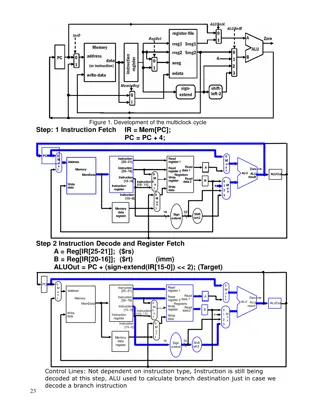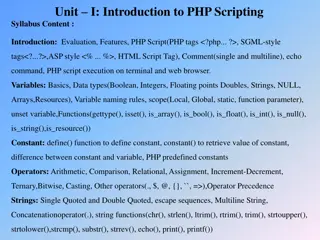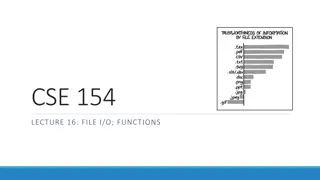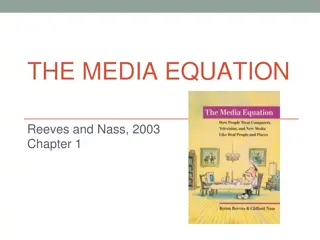
Loop Invariant for Quicksort Algorithm Partition Procedure
Learn how to find an adequate loop invariant for the main while loop in the Partition procedure of the Quicksort algorithm. Understand how this loop invariant ensures that the array is properly partitioned by X[Middle] after the last two assignment statements. Expression in precise mathematical notation included.
Download Presentation

Please find below an Image/Link to download the presentation.
The content on the website is provided AS IS for your information and personal use only. It may not be sold, licensed, or shared on other websites without obtaining consent from the author. If you encounter any issues during the download, it is possible that the publisher has removed the file from their server.
You are allowed to download the files provided on this website for personal or commercial use, subject to the condition that they are used lawfully. All files are the property of their respective owners.
The content on the website is provided AS IS for your information and personal use only. It may not be sold, licensed, or shared on other websites without obtaining consent from the author.
E N D
Presentation Transcript
Algorithms HW6 Willy Chang, Wei-Shao Tang
Problem 3. Find an adequate loop invariant for the main while loop in the Partition procedure of the Quicksort algorithm, which is sufficient to show that after the execution of the last two assignment statements the array is properly partitioned by X[Middle]. Please express the loop invariant as precisely as possible, using mathematical notation.
Problem 3 (Contd). loop invariant guarantees the objective can be satisfied when procedure is done. Objective: The array is properly partitioned by X[Middle]. A good start could be writing the objective in mathematical notation.
Problem 3 (Contd). Algorithm Partition (X, Left, Right) begin pivot := X[Left]; L : = Left; R := Right; while L < R do while X[L] <= pivot and L <= Right do L := L + 1; while X[R] > pivot and R >= Left do R := R - 1; if L < R then swap(X[L], X[R]); Middle := R; swap(X[Left], X[Middle]); end
Problem 3 (Contd). properly partitioned. Left ~ (Middle - 1) Middle (Middle + 1) ~ Right less or equal to pivot pivot greater than pivot
Problem 3 (Contd). Algorithm Partition (X, Left, Right) begin pivot := X[Left]; L : = Left; R := Right; while L < R do while X[L] <= pivot and L <= Right do L := L + 1; while X[R] > pivot and R >= Left do R := R - 1; if L < R then swap(X[L], X[R]); Middle := R; swap(X[Left], X[Middle]); end
Problem 3 (Contd). Algorithm Partition (X, Left, Right) begin pivot := X[Left]; L : = Left; R := Right; while L < R do while X[L] <= pivot and L <= Right do L := L + 1; while X[R] > pivot and R >= Left do R := R - 1; if L < R then swap(X[L], X[R]); Middle := R; swap(X[Left], X[Middle]); end That s what holds right after the main while loop.
Problem 3 (Contd). while L < R do whileX[L] <= pivot and L <= Right do L := L + 1; whileX[R] > pivot and R >= Left do R := R - 1; if L < R then swap(X[L], X[R]);
Problem 3 (Contd). Note that the inequalities i < L and R < j in the second and third conjuncts are strict. (we haven t moved pivot yet.) Right, R Left L The fourth & the fifth conjuncts: 4 1 2 3 The last conjunct indicates when the while condition is over.
Problem 5. You are given a set of n coins {C1, C2, C3 Cn}, among which at least n - 1 are identical "true" coins and at most one coin is "false". A false coin is either lighter or heavier than a true coin. Also, you are given a balance scale, which you may use to compare the total weight of any m coins with that of any other m coins. The problem is to find the "false" coin, or show that there is no such coin, by making some sequence of comparisons using the balance scale. (a) For the case of n = 12, design a scheme to find the false coin (if there is one) with only three comparisons using the balance. Please use {C1, C2, C3 Cn} to identify the coins in your scheme. (b) Prove that, when n = 12, it is not possible to find the false coin with just two comparisons, implying that using just three comparisons is optimal. (Hint: think about decision trees and how many possible outcomes there can be.)
Problem 5 (Contd). First weighing Second weighing Third weighing C1 = C12 (no fake coin) C1 > C12 (C12 light) C1 < C12 (C12 heavy) C10 = C11 (C9 heavy) C10 > C11 (C11 light) C10 < C11 (C10 light) C10 = C11 (C9 light) C10 > C11 (C10 heavy) C10 < C11 (C11 heavy) C1C9 = C10C11 C1C2C3C4 = C5C6C7C8 C1C9 > C10C11 C1C9 < C10C11
Problem 5 (Contd). First weighing Second weighing Third weighing C7 = C8, C4 heavy C7 > C8, C8 ligher C7 < C8, C7 ligher C1 = C2, C6 lighter C1 > C2, C1 heavier C1 < C2, C2 heavier C3 = C12, C5 light C3 > C12, C3 heavier C3 < C12, (impossible) C1C2C5 = C3C6C12 C1C2C3C4 > C5C6C7C8 C1C2C5 > C3C6C12 C1C2C5 < C3C6C12
Problem 5 (Contd). First weighing Second weighing Third weighing C7 = C8, C4 ligher C7 > C8, C7 heavy C7 < C8, C8 heavy C3 = C12, C5 heavier C3 > C12, (impossible) C3 < C12, lighter C1 = C2, C6 heavier C1 > C2, C2 lighter C1 < C2, C1 lighter C1C2C5 = C3C6C12 C1C2C3C4 < C5C6C7C8 C1C2C5 > C3C6C12 C1C2C5 < C3C6C12
Problem 5 (Contd). False coins (lighter or heavier) for 12 coins: 12 * 2 = 24 No false coin: 24 + 1 = 25 possible outcomes One comparison can have >, = , < (3 outcomes) 3^2 = 9 < 25 However, 3^3 = 27 > 25, Hence, three comparisons is optimal.






















